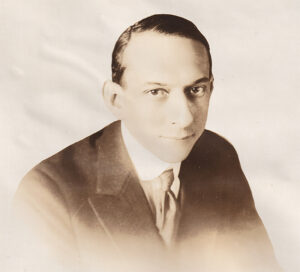 F. Ray Comstock (August 27, 1878-October 15, 1949) was one of the most successful Broadway producers in the 1910s and 1920s. He had hit shows on Broadway and touring for many years, and amassed a fortune as an independent producer. Comstock is also credited with introducing American audiences to the first touring companies of ballet stars from Russia.
F. Ray Comstock (August 27, 1878-October 15, 1949) was one of the most successful Broadway producers in the 1910s and 1920s. He had hit shows on Broadway and touring for many years, and amassed a fortune as an independent producer. Comstock is also credited with introducing American audiences to the first touring companies of ballet stars from Russia.
He was elected to The Lambs in 1914. Comstock was a Lifetime member.
The son of David B. and Emma Comstock of Buffalo, New York, he was connected with the Star Theater in Buffalo before coming to Broadway as a teen. While still in his teens he was an assistant ticket seller at the Criterion Theatre. In 1907, at the age of 28, he produced The Runaways, which was a success from the start. He kept it on the road for three seasons. In succeeding years he produced more than 80 Broadway plays, musicals, and spectacles.
In 1913 on West 39th Street he built the Princess Theatre (demolished in 1955). William A. Swasey was the architect. Comstock’s partners were actor-director (and fellow Lamb) Holbrook Blinn, and the Shuberts to present short plays. The theater was inspired by Paris’ Grand Guignol. When this proved unpopular, it was renamed for actress Lucille La Verne when she appeared in Sun-Up in 1928–only to revert back to the Princess six months later.
Among Comstock’s shows were Very Good Eddie [1915-16], Leave it to Jane [1917-1918], Oh, Lady! Lady! [1918], Oh My Dear (1918-1919), and Uncle Vanya [1923-1927]. With Lamb Morris Gest he brought out many shows, including The Five Million [1919], Chu Chin Chow [1917-1918], Aphrodite [1919-1920], Mecca [1920-1921], and Chauve-Souris [1925-27].
Comstock managed Italian superstar Eleonora Giulia Amalia Duse in her first American appearance, and was credited with discovering actress Marion Davies.
He was hailed for introducing Russian ballet to the United States before World War I. Later the Moscow Art Theater and other ballet groups toured North America under his billing. Comstock said, “If the American theater owes me anything, the debt is more than balanced by what I owe it. And what I owe it is 30 years of delightful association with the most fascinating people in the world.”
He retired from producing after the 1927 season to homes in Florida and Massachusetts.
He was married to Fannie.
Comstock died in Boston on October 15, 1949. He was 71. He is interred in a mausoleum in Woodlawn Cemetery, the Bronx, in the Acacia section.